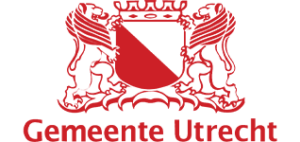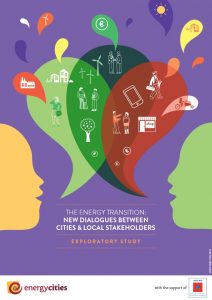Situated in the heart of the Netherlands, Utrecht is a university city with a population of 330,000 and around 70,000 students. Since the population is expected to grow until 2020, the local authority pays great attention to the quality of life in the city. In 2030, Utrecht will be a “clean, sustainable, green and safe”1 city, a pleasant city thanks to the place given to green spaces, air quality, health and the development of soft modes of transport. The municipality’s ambition is also to become a more participative democracy.
In the Netherlands, barely 5% of the population is a member of a political party. Most citizens pay little attention to the actions of the municipality of Utrecht between elections. This is especially true of energy policies. Although the 2009 and 2011 energy and climate plans underwent public consultations, the meetings were always attended by the same people, meaning that the majority of citizens knew little of these plans. But many within the municipality believed that energy was too important an issue to ignore citizens’ priorities.
After reading “Tegen verkiezingen” (Against elections) by David van Reybrouck, the elected representative in charge of sustainable development, Lot van Hooijdonk, suggested that citizens should devise the 2016 energy and climate plan using deliberative democracy principles. This initiative had two objectives: compensate for the democratic deficit in energy policies and give the city the means to rapidly become carbon neutral through intensive collaboration with all the local stakeholders. Thanks to the participation of its residents, the city of Utrecht hoped to create a popular movement that would make the city a pioneer, a truly “energetic heart”2 , where energy would not only be the responsibility of the local authority, but also of all the local stakeholders. Three days of debate were organised in early 2015 to draw up the city’s 2016 energy and climate plan. The discussions focused on a central issue: what more can Utrecht do in order to reach the target of climate-neutral energy provision as quickly as possible?
Method and organisation of the discussion days
Selection of the participants
The representativeness of the panel was a key point in organising the event. The municipality first randomly selected 10,000 people and sent them invitations to participate in drawing up the new energy and climate plan in return for financial compensation (participants could choose between a €300 voucher to be used freely and a €600 voucher redeemable for energy measures or electric transport). 900 people answered favourably. The municipality selected 165, equally distributed in terms of gender and geographic area. Contrary to previous experiments, the compensation offered ensured equal representation of the various neighbourhoods.
The team
Eight municipal staff members prepared the event. In total, ten people were involved before and over the three days: a researcher from the municipality, who selected the participants, a communication officer, a project manager responsible for creating the process (transition manager), an energy expert (information to participants and support for consultants), a project manager from Utrecht energy department, a planning manager, a logistics manager (bike parking places, café, catering, etc.) and a project coordinator. An expert in deliberative democracy chaired the three days of discussion.
Using the services of a consultancy
In order to provide participating citizens with the best possible information, the municipality hired energy consultants. Their missions were essential: production of information sheets to be distributed to the participants before the first day, preparation of an energy scenario, presence of experts for special themes, reporting on the atmosphere during the discussions and recording of the participants’ contributions into a draft energy plan.
The discussion days (March and April 2015)
After a long preparation process, the 165 selected participants met three times on Saturdays in March and April 2015.
Day 1: “Dreaming of the future” (14th March 2015)
During this first, rather open day, the participants were able to discuss with experts and between each other and tried to imagine their city in the future. To encourage them to dream, several questions were put to them: what will Utrecht look like in 2030? What can we do to make these dreams a reality (use less energy, produce more sustainable energy, etc.)? What strategy should be adopted? The answers were as varied as innovative. Some were even quite unexpected: a teacher even suggested nuclear fusion!
Day 2: “Building scenarios” (28th March 2015)
During this day, the municipality imposed a number of constraints on the participants: budget, yields, technical means, impacts, etc. The aim was for citizens to build scenarios and assess their consequences in terms of economic impact, jobs and comfort, thanks to a specifically designed simulator. Two independent experts also presented their vision of a climate-neutral Utrecht. Given the difficulty of devising a scenario by 165 people, the participants organised the proposed measures into three categories: measures to be eliminated, measures approved by the majority, and measures requiring certain conditions for their implementation.3 . Finally, a list of 10 priorities was drawn up for each sector: housing, work and transport.
Day 3: “Devising the energy and climate plan” (18th April 2015)
After reading the draft energy plan and listening to the opinions of business representatives, social landlords and energy companies regarding the previously defined priorities, the participants were asked to draw up a provisional energy and climate plan that was presented to the councillor in charge of sustainable development at the end of the day. On this occasion, the municipality was able to appreciate the ability of citizens to discuss with stakeholders and to think comprehensively.
What are the next steps?
The participants were very clear about their desire to keep track of the process. To guarantee transparency, the municipality set up a number of monitoring levels. Once the energy plan has been formed into an action plan by the city council, the municipality will invite all the participants to a meeting in April 2016 so that they can express their opinion on how their priorities have been translated into concrete actions.
Information is also regularly sent by e-mail to report on the progress made in forming the energy plan. Invitations to city council debates have also been made and the municipal departments have remained available for advice.
The Energy Plan
Ultimately, the Energy Plan that was drawn up was quite ambitious but not fully-fledged and remained halfway between a vision and a scenario 4 . The municipality, however, really appreciated how the participants approached the issues, for example on behavioural aspects or the integrated dimension of energy. Participants also mentioned examples where the efforts of the municipality were not sufficiently integrated in development areas. This approach also led citizens to identify conditions that would improve social acceptance of district heating networks or wind turbines. Concerning the heating network, they demanded more transparency and that citizens be part of the decision-making process. This would give the municipality more legitimacy in the future negotiations with the heating network operator.
Overall, the municipality was positively surprised at how participants were able to find common ground, not only with it but with other stakeholders like Eneco, the heating company or Stedin, the energy distribution operator. This will certainly encourage the municipality to include citizens in negotiations with other partners on a more frequent basis.
Feedback from stakeholders
Overall, the team in charge of the project noted that participants were genuinely enthused about the approach and very keen to learn more. 97.5% said they were satisfied or very satisfied with these three days of discussion, which seem to have stimulated a real reflection about energy and the ability of citizens to take action, whether at individual, community, neighbourhood or city levels.
A good example of the interest shown by citizens in the approach is the fact that many opted for the €600 vouchers redeemable for energy measures (56 participants) instead of the initially highly coveted €300 gift voucher (chosen however by 109 participants).
The role of the municipality
Finding out what participants wanted from the municipality was one of the most unexpected outcomes of these three days of discussion. Throughout the process, the city of Utrecht feared adopting a lecturing or preaching role. Surprisingly, the participants asked the municipality to assume this role more often. According to them, the municipality must play an active role in the energy transition process for it has the power to initiate many of the desired measures. It must also stimulate change in behaviour by providing information (energy information service, energy publication, website, energy ambassadors, etc.) and enhanced visibility to energy initiatives (installation of solar panels on municipal buildings for example). Neither do citizens exclude the possibility of the municipality becoming an energy supplier in the long term, which would clearly affirm its pivotal role in the local energy policy.
Following this process, the municipality has thus reviewed its own roles:
- Directive role (strategic choices, notably on a large scale, such as using the district heating network in the city) ;
- Legislative/enforcement role (public law, enforcing energy saving measures under the Dutch Environmental Management Act);
- Role as facilitator and catalyst (facilitating initiatives like purchasing schemes for solar panels), and
- Role model (setting an example in the market, the municipality being responsible for part of local emissions, and becoming a regional or even national leader).
For both citizens and the municipality, it appears key that the latter combines bottom-up approaches (inspiring citizens, supporting spontaneous movements) with top-down approaches (creating optimal regulatory and financial conditions for the energy transition).
Future prospects
After the energy plan drawn up by the citizens was presented to Utrecht City Council, the Utrecht Energy Agendas 2016-2019 were published in autumn 2015. These translate the energy plan into practical measures embedded into other local energy and climate policies. The idea is to get back to the participants once the action plan is defined, to see if they recognise the result of their inputs.
For the sake of transparency and to continue the participation process started, the municipality is looking for tools to maintain the level of motivation of the participants and harness the momentum of enthusiasm generated by the discussions. With these discussions, the municipality hopes to start a citizens’ movement and spread it across the city by word of mouth. It is also considering following the advice of participants by adopting a combination of bottom-up and top-down approaches with other stakeholders.
“The city-wide conversation has taught us that we can only bring about the desired energy transition with a joint approach in which everyone feels ownership and has their own roles and responsibilities and in which alliances are forged around ever-changing issues. This calls for a common approach: top-down and bottom-up. An approach focused on technology, market, awareness, attitude and behaviour. And an approach focused on short-term and long-term breakthroughs. We are riding the coattails of a movement that has already begun. We want to create more movement, support the movement there already and make further movement possible5 .” Municipality of Utrecht.
Considering that energy is too important an issue for citizens not to have their say on it, the decision to have citizens draw up the Utrecht Energy Plan 2016 is a concrete and successful example of deliberative democracy. It revealed the importance of governance that is half-way between top-down and bottom-up, ensuring that all stakeholders are involved in the energy transition process.


